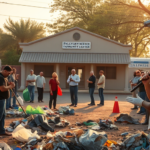Oil Spill Causes Temporary Road Closure in San Benito, Provokes Community Concern
This week’s events in San Benito, Texas, have served as a stark reminder of the delicate balance between industry and safety in the Rio Grande Valley. On January 3, 2025, a tractor malfunction resulted in an oil spill of approximately 125 gallons, prompting the Texas Department of Transportation (TxDOT) to close parts of FM 509. Though the roads have been reopened, the incident highlighted ongoing concerns about environmental safeguards in South Texas.
Unfolding the Incident
Local RGV news outlets, including the community-focused ValleyCentral, reported that the spill extended nearly a quarter-mile between Shafer Road and the railroad tracks near FM 509. The initial response was swift, with TxDOT closing the southbound outside lane to deal with the situation effectively. A specialized chemical response team was dispatched to manage and expedite clean-up efforts.
Erik Navarro, a representative from TxDOT, commented, “Our priority is to ensure the safety of Valley residents. We coordinated quickly to address the spill and mitigate any potential hazards.”
The cause of the spill has been traced to a tractor mishap, a situation that, although rare, has underscored a need for stringent checks and better maintenance protocols.
Community Impact and Environmental Concerns
The Rio Grande Valley, an area known for its dynamic environment and community, felt the immediate effects of the spill. While the incident did not escalate to catastrophic levels, it further inflamed environmental concerns among residents who regularly deal with industrial challenges.
Local resident Maria Lopez voiced her concerns, stating, “We understand things happen, but this kind of spill near residential areas is worrying. San Benito and other towns in the Valley have to live with the consequences of such accidents, raising questions about long-term safety and environmental stewardship.”
Environmental groups have echoed these sentiments, emphasizing the need for ongoing vigilance and improved industry practices to prevent similar occurrences. The spill has reinforced calls for a review of the emergency response protocols, ensuring measures are in place to swiftly address spills and protect water and wildlife.
Connections to Previous Incidents
This is not the first incident of its kind in the region, drawing parallels to previous local spills that have tested community resilience. These events have historically created disruptions and incited discussions about both industrial responsibility and state oversight.
Paul Martinez, an environmental activist in the RGV, remarked, “It’s crucial for our government to work hand-in-hand with industries to establish preventive measures. Our Valley’s natural beauty and resources are precious; we must safeguard them.”
Community forums have been pivotal in these discussions, bringing together stakeholders to propose solutions and foster understanding between industry and the public.
Moving Forward: Proposed Measures and Future Implications
Looking ahead, the spill may serve as a catalyst for change, prompting local authorities to consider implementing stricter regulatory measures and improving inspection routines for industrial equipment. These measures could also extend to encouraging better training for workers handling hazardous materials.
There is a fine balance to maintain in encouraging industrial growth and protecting community interests, a challenge the Valley has continually navigated. Proactive steps, such as community education on spill response and environmental issues, could further bridge gaps.
San Benito Mayor Ricardo Hernandez stated, “We’re committed to working with both TxDOT and our residents to ensure incidents like this inform better policies and practices. Building transparency and trust is key to our community’s resilience.”
Residents are encouraged to stay informed and report concerns to help monitor local environmental conditions. ValleyCentral frequently provides updates and insights into regional safety measures, making it a valuable resource for Valley residents.
Key Takeaways for Valley Residents
As the immediate effects of the spill are addressed, its broader implications invite reflection on industrial practices in the Rio Grande Valley. By adopting a collaborative, informed approach, the community can better safeguard its future.
For residents seeking further information or wishing to express concerns, TxDOT and local government offices are available as points of contact. Community engagement will be vital as discussions continue, ensuring Valley residents’ voices drive future measures.
Through sustained effort and an emphasis on local impact, San Benito and the broader Rio Grande Valley can continue to thrive while mitigating the risks of industrial development. The ongoing narrative of balancing growth with environmental stewardship remains ever relevant in this vibrant South Texas region.







